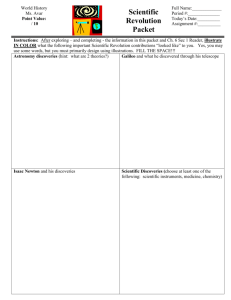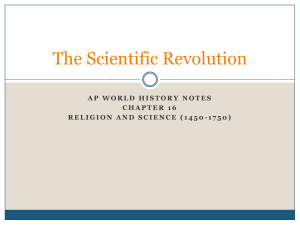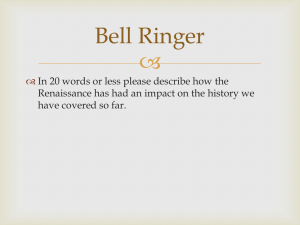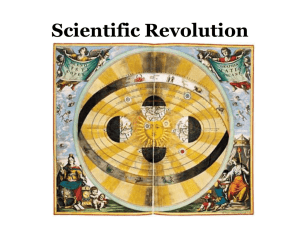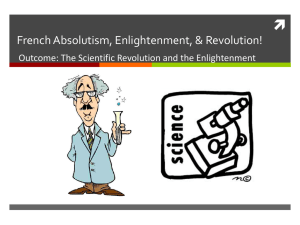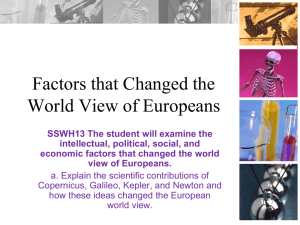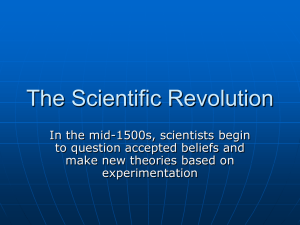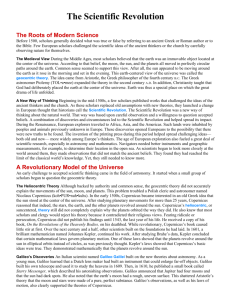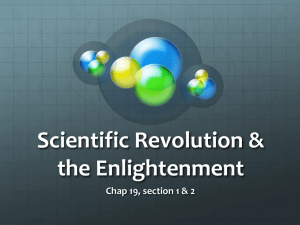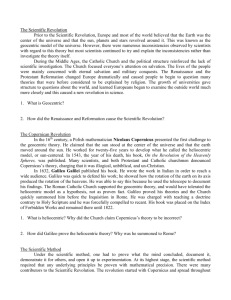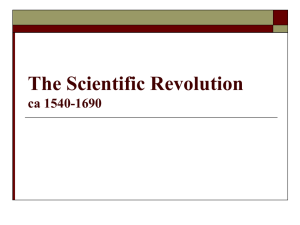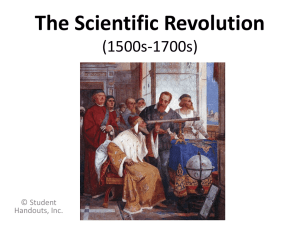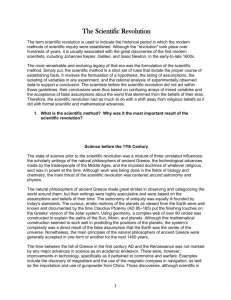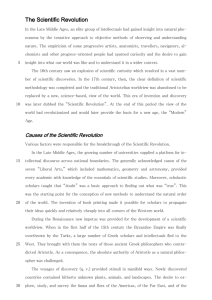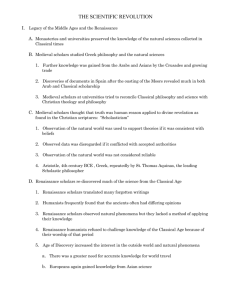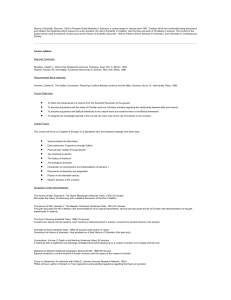Chapter 22: Enlightenment and Revolution, 1550
advertisement
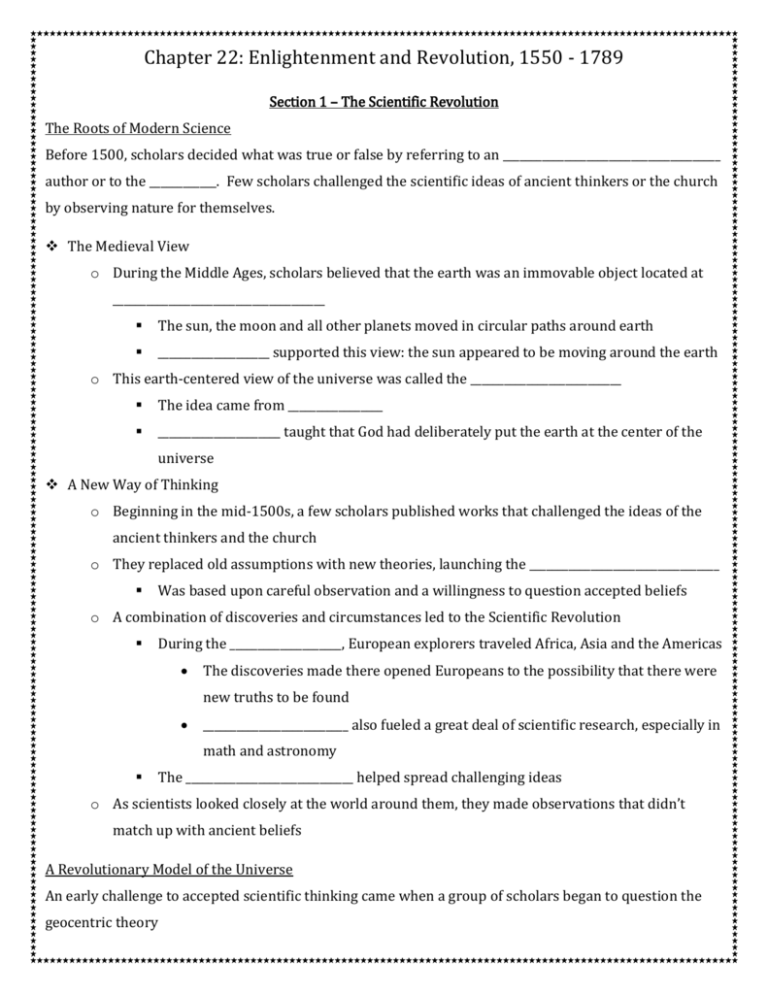
Chapter 22: Enlightenment and Revolution, 1550 - 1789 Section 1 – The Scientific Revolution The Roots of Modern Science Before 1500, scholars decided what was true or false by referring to an _______________________________________ author or to the ____________. Few scholars challenged the scientific ideas of ancient thinkers or the church by observing nature for themselves. The Medieval View o During the Middle Ages, scholars believed that the earth was an immovable object located at ______________________________________ The sun, the moon and all other planets moved in circular paths around earth ____________________ supported this view: the sun appeared to be moving around the earth o This earth-centered view of the universe was called the ___________________________ The idea came from _________________ ______________________ taught that God had deliberately put the earth at the center of the universe A New Way of Thinking o Beginning in the mid-1500s, a few scholars published works that challenged the ideas of the ancient thinkers and the church o They replaced old assumptions with new theories, launching the __________________________________ Was based upon careful observation and a willingness to question accepted beliefs o A combination of discoveries and circumstances led to the Scientific Revolution During the ____________________, European explorers traveled Africa, Asia and the Americas The discoveries made there opened Europeans to the possibility that there were new truths to be found __________________________ also fueled a great deal of scientific research, especially in math and astronomy The ______________________________ helped spread challenging ideas o As scientists looked closely at the world around them, they made observations that didn’t match up with ancient beliefs A Revolutionary Model of the Universe An early challenge to accepted scientific thinking came when a group of scholars began to question the geocentric theory Chapter 22: Enlightenment and Revolution, 1550 - 1789 Heliocentric Theory o The geocentric theory did not accurately explain the movements of the sun, moon and planets o This troubled Nicolaus Copernicus Became interested in an old ___________ idea that the __________ stood at the center of the universe After studying planetary movements for 25 years, he reasoned that the earth and other planets _______________________________ His _______________________________, or sun-centered, theory did not explain why the planets orbited the way they did Also knew that most scholars and clergy would ____________ his theory because it contradicted their religious views Fearing ridicule and persecution, he did not publish his findings until _________________________________________in 1543 o Over the next century and a half, scientists built on the foundation he laid In 1601, Johannes Kepler concluded that certain mathematical laws govern planetary motion 1 of these laws showed that planets revolve around the sun in _____________________ ________________ Kepler’s laws showed that Copernicus was right by demonstrating ________________________ that the earth revolved around the sun Galileo’s Discoveries o An Italian scientist named Galileo Galilei had learned that a Dutch lens maker had built an instrument that could enlarge far-off objects Build his own telescope and used it to study the heavens in 1609 o In 1610, he published a book called ____________________________, which described his observations Announced that Jupiter had 4 moons and that the sun had dark spots Noted the earth’s moon had a rough, uneven surface Shattered __________________________ theory that the moon and stars were made of a pure, perfect substance o Galileo’s observations along with his laws of motion, _________________ the theories of Copernicus Conflict with the Church o Galileo’s findings frightened _______________________________ leaders Chapter 22: Enlightenment and Revolution, 1550 - 1789 If people believed the church was wrong about this, they could question other church teachings o In 1616, the Catholic Church warned Galileo not to defend Copernicus’s ideas He remained publicly silent but __________________________________ o In 1632, he published another book where he once again supported the ideas of Copernicus The pope summoned him to Rome to stand trial before the _____________________ Stood before the court and under the threat of torture, read aloud a signed confession agreeing that Copernicus’ ideas were false o Was never free again, living under _______________________ until his death in 1642 His books and ideas still spread all over Europe In ____________, the Catholic Church officially acknowledged that Galileo had been right The Scientific Method The revolution in scientific thinking that Copernicus, Kepler and Galileo began developed into a new approach called the ___________________________, a logical procedure for gathering and testing ideas. Bacon and Descartes o The work of 2 important thinkers in the 1600s helped to advance the scientific method _____________________ Believed by better understanding the world, scientists would generate practical knowledge that would improve people’s lives He urged scientists to experiment and then draw conclusions o Called ____________________, or the ___________________________________ _______________________ Rather than relying in experimentation, he relied on _______________________________ Believed everything should be doubted until proven by reason o The only thing he knew for certain was that he existed because, as he famously wrote, “I think, therefore I am” o Modern scientific methods are based on the ideas of Bacon and Descartes The Scientific Revolution Spreads Scientific Instruments o The first __________________ was invented by a maker of eyeglasses, Zacharias Janssen, in 1590 Chapter 22: Enlightenment and Revolution, 1550 - 1789 In 1670, Anton van Leeuwenhoek (LAY*vuhn*huk) used a microscope to observe bacteria and examined blood cells for the first time o In 1643, Evangelista Torricelli developed the first mercury barometer, a tool for measuring atmospheric pressures and ___________________________ o In 1714, Gabriel Fahrenheit made the first thermometer to use mercury in glass o Anders Celsius created another scale for the mercury thermometer in 1742 Medicine and the Human Body o During the Middle Ages, European doctors accepted as fact the writings of an ancient Greek physician named Galen Galen had never dissected a human body, instead relying on his studies of ________________ ________________________, assuming that human anatomy was the same o A physician named Andreas Vesalius proved Galen wrong Dissected human corpses and published his observations o In the late 1700s, British physician Edward Jenner introduced a vaccine to prevent _____________ Jenner discovered that inoculation with germs from a cattle disease called _______________ gave permanent protection from smallpox and it to create the world’s ___________________________ Discoveries in Chemistry o Robert Boyle pioneered the use of the scientific method in ___________________ Challenged Aristotle’s theory that the physical world consisted of four elements – ___________________________________________________ Proposed that matter was made up of smaller primary particles that joined together in different ways
